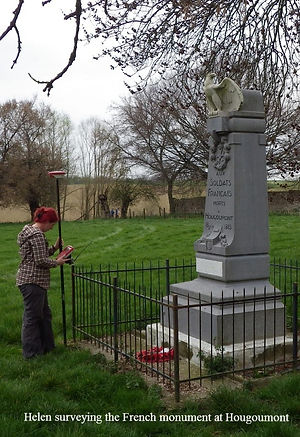

Archaeology@Waterloo





Welcome to the
ARCHAEOLOGY @ WATERLOO
research web site
INTRODUCTION
This site displays the work of a small group of professional archaeologists and historians who have collectively carried out archaeological and historical research work on the Waterloo Battlefield. The work is not led by any one organisation or individual and it is generally unfunded although some organisations and individuals have very kindly paid for some aspects of the work in order to increase the knowledge and the potential preservation of this important historic monument.
The fieldwork began at Hougoumont Farm in March 2014 in reaction to the extensive renovations that were being carried out on the site. A great deal of earth had already been disturbed before the project fieldwork began and so the initial aspect of the research attempted to record any archaeological remains before they were further disturbed.
Background to the work at Waterloo
In 2002 Jeremy Freeston first approached Tim Sutherland to discuss the archaeology of the battlefield at Waterloo. Jeremy is a knowledgeable Waterloo historian who wanted to know if it was potentially possible to locate the areas of ground where the dead soldiers at Hougoumont Farm had been buried following the battle. Jeremy had approached Tim due to the latter's successful fieldwork on the medieval battlefield at Towton (1461) in North Yorkshire, where in 1996 he and his colleagues had excavated a mass grave of former combatants at Towton Hall . Using battlefield archaeology principles Tim later found additional mass graves from the battle of Towton in the centre of the battlefield.
At that time Jeremy was due to make a documentary for the television series Battlefield Detectives and was looking for a good archaeological perspective for a Waterloo story. The concept was discussed further, but it was later found that the time frame required to apply for permissions and seek approval to excavate from the Belgium authorities fell outside the scope of the programme schedule. An alternative storyline was therefore discussed (Massacre at Waterloo) and the former aspect of the Waterloo research was shelved, with the hope that the work at Hougoumont would be resurected at some time in the future.
In 2014 an opportunity arose where Jeremy and Tim could undertake the initially proposed fieldwork. In March of that year their team arrived at Hougoumont with a van full of geophysical survey equipment and an outline of what was proposed. Confirmation was sought with the Belgian authorities that no other archaeological work at Hougoumont had been officially planned as the team felt that it was unacceptable to undertake archaeological work on sites that others had already begun work, without their approval. They were therefore surprised but relieved to find that nobody else had already started archaeological work at the farm. The team therefore believed that they would be initiating new, important and timely work as renovation work on the farm had already begun in preperation for the 2015 bicentennial commemorations, and large areas of ground had already been disturbed with virtually no archaeological recording. The team also applied for permission to carry out limited test excavations and archaeological metal detecting surveys. Unfortunately permission for these was not immediately forthcoming although we were encouraged to be told that this was not forbidden in general.
Project Aims & Objectives
The aim of the project was to record archaeological evidence, of all periods, at the Farm of Hougoumont, Waterloo, Belgium. This includes the archaeology of the land, the buildings within it and the people that once inhabited the landscape. The objectives were to carry out a number of archaeological surveys that would record this evidence so that anyone would then be able to interpret the new data. This would assist the understanding of many of the events that have taken place within the landscape, the most famous of which was The Battle of Waterloo.
Fieldwork
Each time the team worked on site they were met by members of the Belgian archaeological authorities, either Didier Willems or Dominique Bosquet, who discussed the proposed work.
Helen Goodchild undertook the preliminary Fluxgate Gradiometer (Magnetic or Mag’) surveys within the walled garden and also near to the North Gate where it is believed some of the burial pits of the combatants were located. Helen and Tim also undertook a Ground Penetrating RADAR (GPR) survey over an area of ground near to the South Gate where other burials were believed to be situated. In addition Tim undertook a GPR survey of a section of track next to the farm to investigate an unusual feature. Helen, Dave Halsted and Tim undertook a small Resistivity (Res’) Survey at the North Gate and in the Walled Garden. The aim of these surveys was to confirm the potential viability for these forms of prospection at Hougoumont. The results were very encouraging. Dave carried out a photogrammetric survey of the wall surrounding the garden which produces a 3D representation of the structure prior to its later complete refurbishment. It is now, as far as we know, the only existing survey of its type at Hougoumont. Dave also carried out a similar survey over other structures and features, including a survey of the Hollow (or Covered) Way and also the garden surface itself allowing a digital terrain model to be constructed of the micro topography of the former internal layout.
In January 2015 the team returned with geophysicists from GSB Prospection (the former Time Team’s 'geophys' company) who carried out extensive work around the farm using both Mag’ and Res’.
Once again the team applied for permission to archaeologically metal detect both the ground, and also the walls and large trees which exist on the site, for non-ferrous evidence of battle, such as pistol and musket balls. Unfortunately this permission was not forthcoming.